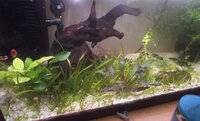Shawnmac, the following two links to Wikipedia describe how magnesium deficiency and photorespiration both effect the photosynthetic efficiency of plants and may ultimately impact on the health of plants.
There is lots of anecdotal evidence of insufficient CO2 causing on outbreak of BBA. There is lots of discussion about other potential causes too. Why should a reduction in CO2 directly benefit an organism that uses photosynthesis to produce energy and grow? Other indirect mechanisms must be at work, that the aquarist may be controlling. What could these be?
This information on Wikipedia seemed relevant:
https://en.m.wikipedia.org/wiki/Magnesium_in_biology#Plant_physiology_of_magnesium
In
animals, it has been shown that different cell types maintain different concentrations of magnesium.
[6][7][8][9] It seems likely that the same is true for
plants.
[10][11] This suggests that different cell types may regulate influx and efflux of magnesium in different ways based on their unique metabolic needs. Interstitial and systemic concentrations of free magnesium must be delicately maintained by the combined processes of buffering (binding of ions to proteins and other molecules) and muffling (the transport of ions to storage or extracellular spaces
[12]).
In plants, and more recently in animals, magnesium has been recognized as an important signaling ion, both activating and mediating many biochemical reactions. The best example of this is perhaps the regulation of
carbon fixation in
chloroplasts in the
Calvin cycle.
[13][14]
Magnesium is very important in cellular function. Deficiency of the
nutrient causes disease of the affected organism. In single-cell organisms such as
bacteria and
yeast, low levels of magnesium manifests in greatly reduced growth rates. In magnesium transport
knockout strains of bacteria, healthy rates are maintained only with exposure to very high external concentrations of the ion.
[15][16] In yeast,
mitochondrial magnesium deficiency also leads to disease.
[17]
Plants deficient in magnesium show stress responses. The first observable signs of both magnesium starvation and overexposure in plants is a decrease in the rate of
photosynthesis. This is due to the central position of the Mg2+ ion in the
chlorophyllmolecule. The later effects of magnesium deficiency on plants are a significant reduction in growth and reproductive viability.
[3] Magnesium can also be toxic to plants, although this is typically seen only in
drought conditions.
[18][19]
Also, the following appears to be relevant concerning the effects of a deficiency of magnesium:
Magnesium has an important role in
photosynthesis because it forms the central atom of
chlorophyll.
[1] Therefore, without sufficient amounts of magnesium, plants begin to degrade the chlorophyll in the old leaves. This causes the main symptom of magnesium deficiency,
chlorosis, or yellowing between leaf veins, which stay green, giving the leaves a marbled appearance. Due to magnesium’s mobile nature, the plant will first break down chlorophyll in older leaves and transport the Mg to younger leaves which have greater photosynthetic needs. Therefore, the first sign of magnesium deficiency is the chlorosis of old leaves which progresses to the young leaves as the deficiency continues.
[4] Magnesium also is a necessary activator for many critical enzymes, including ribulosbiphosphate carboxylase (
RuBisCO) and
phosphoenolpyruvate carboxylase (PEPC), both essential enzymes in
carbon fixation. Thus low amounts of Mg lead to a decrease in photosynthetic and enzymatic activity within the plants. Magnesium is also crucial in stabilizing
ribosome structures, hence, a lack of magnesium causes
depolymerization of ribosomes leading to pre-mature aging of the plant.
[1] After prolonged magnesium deficiency,
necrosis and dropping of older leaves occurs. Plants deficient in magnesium also produce smaller, woodier fruits.
The following relates to photorespiration:
Photorespiration (also known as the
oxidative photosynthetic carbon cycle, or
C2 photosynthesis) refers to a process in
plant metabolism where the
enzyme RuBisCOoxygenates
RuBP, causing some of the energy produced by photosynthesis to be wasted. The desired reaction is the addition of
carbon dioxide to RuBP (
carboxylation), a key step in the
Calvin–Benson cycle, however approximately 25% of reactions by RuBisCO instead add oxygen to RuBP (
oxygenation), creating a product that cannot be used within the Calvin–Benson cycle. This process reduces the efficiency of photosynthesis, potentially reducing photosynthetic output by 25% in
C3plants.
[1] Photorespiration involves a complex network of enzyme reactions that exchange metabolites between
chloroplasts, leaf
peroxisomes and
mitochondria.
The oxygenation reaction of RuBisCO is a wasteful process because
3-Phosphoglycerateis created at a reduced rate and higher metabolic cost compared with
RuBP carboxylase activity. While photorespiratory carbon cycling results in the formation of G3P eventually, there is still a net loss of carbon (around 25% of carbon fixed by photosynthesis is re-released as CO2)
[2] and nitrogen, as
ammonia.
Ammonia must be detoxified at a substantial cost to the cell. Photorespiration also incurs a direct cost of one
ATP and one
NAD(P)H.






